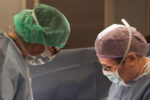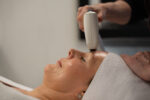General surgery
To ensure accurate diagnoses, we utilize imaging techniques such as X-rays, MRI, and ultrasound, as well as pathology examinations when needed. We also offer in-house laboratory services, which help us determine the correct diagnosis under one roof.

Services
Book an appointment
You can easily book an appointment through our online booking system or by calling our customer service.
Services
General surgery
Hernia surgery is one of the most common surgical procedures at Sf-cliniken. The procedure is performed by a specialist in general surgery with extensive experience and advanced techniques for hernia treatment. The surgeries are conducted as day procedures, either under local anesthesia or general anesthesia.
Frequently Asked Questions About Hernia Surgery
How does a hernia form?
A hernia forms when the abdominal contents, such as the small intestine, covered by the peritoneum, push through the inguinal canal into the subcutaneous layer. A hernia typically appears as an outward bulge. Hernias are most common in the groin area or the front of the abdomen around the navel.
Inguinal Hernia: How does it form, and how is it treated?
Inguinal hernias are the most common type of hernia. They can occur at any age but become more frequent with age. Inguinal hernias are primarily a male condition, with 95% of cases occurring in men. A hernia will not heal on its own, and surgery is required if it causes discomfort.
An inguinal hernia appears as a soft lump in one or both groins, as hernias can sometimes occur on both sides. The lump usually disappears when resting. While hernias do not always cause pain, they often cause minor discomfort during activities such as movement. Severe pain in the hernia area is a reason to seek medical attention immediately.
During surgery, a 7 cm incision is made in the groin, through which the surgeon opens the inguinal canal and pushes the hernia sac back into the abdominal cavity. A mesh is placed over the tear or opening to reinforce the abdominal wall and prevent a new hernia from forming. After the procedure, our staff will monitor your condition briefly before you are discharged. Recovery is quick, and extended sick leave is typically not necessary.
Umbilical Hernia: How does it form, and how is it treated?
An umbilical hernia occurs when part of the intestine or peritoneum pushes through the abdominal muscles to the front, beneath the skin around the navel. Central obesity and pregnancies in women increase the risk of umbilical hernias.
An umbilical hernia may cause mild pain and a feeling of stretching. Other symptoms include abdominal pain and vomiting. Severe pain in the hernia area is a reason to seek medical attention immediately.
At Sf-cliniken, umbilical hernia surgery is performed as a day surgery under local anesthesia. During the procedure, an incision is made at the site of the bulge, and the surgeon pushes the hernia sac back into the abdominal cavity and closes the hernia opening. The edges of the peritoneum are sutured together. This surgery is suitable for small hernias. For larger umbilical hernias, a mesh is placed over the hernia opening to reinforce the abdominal wall and prevent a recurrence. After the procedure, our staff will monitor your condition briefly before you are discharged. Recovery is quick, and extended sick leave is typically not necessary.
Incisional Hernia: How does it form, and how is it treated?
An incisional hernia forms in a previous surgical scar, where an incision was made through the skin and muscle layers of the abdomen. A surgical scar is never as strong as the original abdominal wall. Over time, a hernia can develop in the scar of a previous abdominal surgery.
Incisional hernias are not usually dangerous but can be uncomfortable. Surgery to repair an incisional hernia is performed under general anesthesia.
How should I prepare for the surgery?
Before the surgery, you will need to attend an examination and preoperative visit with our surgeon. During this visit, the procedure will be scheduled, and you will receive detailed instructions on how to prepare for the surgery and what to do afterward.
Hemorrhoids are not dangerous but are often uncomfortable and painful. In rare cases, hemorrhoids can be associated with a tumor in the rectum.
At Sf-cliniken, hemorrhoid surgeries are performed by a specialist in general surgery. The procedure is done as day surgery under local anesthesia.
Frequently Asked Questions about Hemorrhoids
What are hemorrhoids?
Hemorrhoids are a type of varicose vein. Normally, they are part of the network of blood vessels located in the rectal area. Due to increased pressure, some of these blood vessels may become enlarged. Hemorrhoids are classified as internal or external depending on their location. Common causes of hemorrhoids include constipation, prolonged sitting, obesity, and pregnancy. The most common treatment method is rubber band ligation.
What are the symptoms of hemorrhoids?
The most common symptom is bleeding, with bright red blood visible during bowel movements or on toilet paper. Other symptoms include itching, discomfort, and occasionally pain or issues with bowel control. Symptoms may vary over time, being minimal at times and more troublesome at others.
When should I seek medical care?
Seek medical care if the bleeding is heavy, symptoms persist despite self-care, if the hemorrhoids have prolapsed outside the anus, or if they cause sudden and severe pain.
How are hemorrhoids treated?
Hemorrhoids are initially treated with over-the-counter medications available at the pharmacy. Temporary pain relief can be achieved with creams that have a numbing effect. At the clinic, a surgeon examines the hemorrhoids and plans an appropriate treatment.
The most common method for internal hemorrhoids is rubber band ligation, especially if the hemorrhoids frequently bleed. Hemorrhoids are "tied off" by placing a rubber band at their base. After about 7–10 days, the hemorrhoids and rubber bands fall off. The treatment can be repeated after a month if hemorrhoids remain. The procedure is painless.
After the procedure, minor bleeding from the rectal area may occur. If rubber band ligation is not effective enough, the hemorrhoids can be surgically removed, also under local anesthesia. The procedure is quick and painless, and sick leave is usually not required. However, some pain may occur in the days following surgery.
How should I prepare for the procedure?
On the day of the procedure, shower and ensure that the bowel is properly emptied beforehand. Leave all jewelry at home, and if you use a hearing aid, bring it with you. Also, remember to take your regular medications, such as blood pressure medication, asthma inhalers, insulin, and your own blood sugar meter.
Eat normally on the day of the procedure and take your medications as instructed by your doctor. Hemorrhoid surgery is usually performed under local anesthesia, and general anesthesia is rarely needed. The procedure itself takes about 30 minutes, after which your condition will be monitored for a short time in the recovery room.
At Sf-cliniken, birthmark removal is performed by a specialist in general surgery, plastic surgery, or vascular surgery. Birthmarks in the eye and facial areas are typically removed by a plastic surgeon.
Frequently Asked Questions About Skin Lesion Removal
When should I see a doctor?
If a birthmark changes in size, shape, or color, or starts to bleed, you should book an appointment with a doctor. A malignant birthmark usually looks different from normal, harmless birthmarks.
How is the procedure performed, and how long does it take?
The procedure is performed under local anesthesia. Once the area is numbed, the doctor surgically removes the lesion and closes the wound with either removable or absorbable stitches. Finally, a dressing is applied to the wound. You can go home afterward if you feel well.
The time required for removing a skin lesion depends on the number and size of the lesions, but the procedure typically takes about 15–60 minutes.
How should I prepare for the procedure?
The procedure does not require any special preparation. Skin lesions are removed on an outpatient basis under local anesthesia. If you are taking blood-thinning medication, you must inform the medical staff in advance.
How do I recognize a lipoma, and how is it removed?
A lipoma, or subcutaneous lump, can have several causes but is most often a benign condition. However, the nature and origin of the lipoma should be evaluated by a doctor, especially if the lipoma has grown rapidly, is larger than 5 cm in diameter, or if the skin above it has become red.
Lipoma removal is performed as a day surgery under local anesthesia. Recovery time and the duration of the procedure depend on the size of the lipoma.
High-quality service and treatment facilities
We are known for our unhurried customer service, uncompromising professionalism, and welcoming facilities. With us, you’re in good hands. We speak Finnish, Swedish, and English, and our dedicated team of experienced specialist doctors, nurses, massage therapists, hairdressers, and cosmetologists is here for you.




